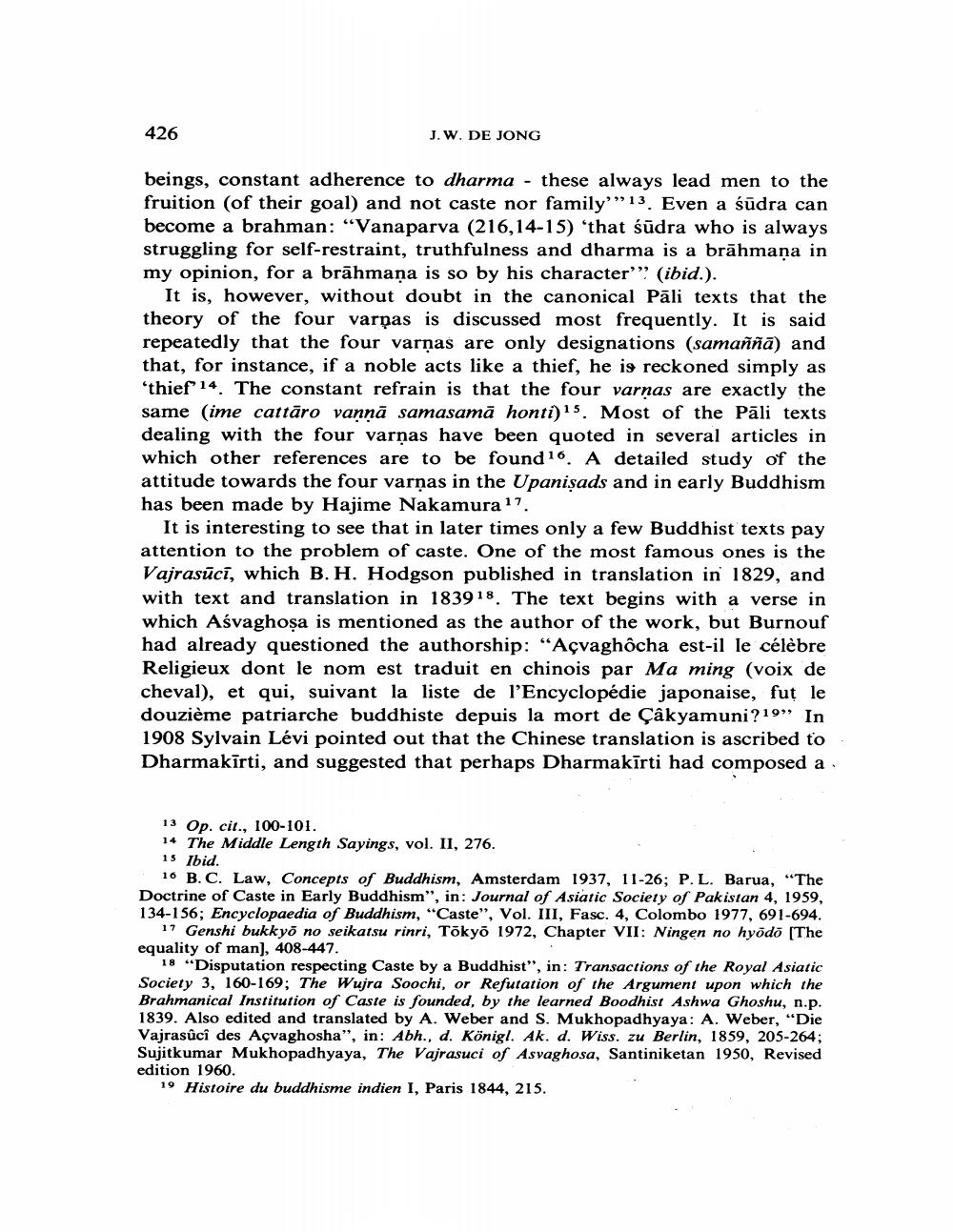Book Title: Buddhism And Equality Of Four Castes Author(s): J W De Jong Publisher: J W De Jong View full book textPage 4
________________ 426 J. W. DE JONG beings, constant adherence to dharma - these always lead men to the fruition (of their goal) and not caste nor family""13. Even a śūdra can become a brahman: "Vanaparva (216,14-15) 'that südra who is always. struggling for self-restraint, truthfulness and dharma is a brahmana in my opinion, for a brähmaṇa is so by his character"" (ibid.). It is, however, without doubt in the canonical Pāli texts that the theory of the four varpas is discussed most frequently. It is said repeatedly that the four varņas are only designations (samaññā) and that, for instance, if a noble acts like a thief, he is reckoned simply as 'thief 14. The constant refrain is that the four varnas are exactly the same (ime cattāro vannā samasama honti) 15. Most of the Pāli texts dealing with the four varṇas have been quoted in several articles in which other references are to be found 16. A detailed study of the attitude towards the four varņas in the Upaniṣads and in early Buddhism has been made by Hajime Nakamura 17. It is interesting to see that in later times only a few Buddhist texts pay attention to the problem of caste. One of the most famous ones is the Vajrasuci, which B. H. Hodgson published in translation in 1829, and with text and translation in 1839 18. The text begins with a verse in which Aśvaghosa is mentioned as the author of the work, but Burnouf had already questioned the authorship: "Açvaghôcha est-il le célèbre Religieux dont le nom est traduit en chinois par Ma ming (voix de cheval), et qui, suivant la liste de l'Encyclopédie japonaise, fut le douzième patriarche buddhiste depuis la mort de Çâkyamuni?19" In 1908 Sylvain Lévi pointed out that the Chinese translation is ascribed to Dharmakirti, and suggested that perhaps Dharmakirti had composed a 13 Op. cit., 100-101. 14 The Middle Length Sayings, vol. II, 276. 15 Ibid. 16 B. C. Law, Concepts of Buddhism, Amsterdam 1937, 11-26; P. L. Barua, "The Doctrine of Caste in Early Buddhism", in: Journal of Asiatic Society of Pakistan 4, 1959, 134-156; Encyclopaedia of Buddhism, "Caste", Vol. III, Fasc. 4, Colombo 1977, 691-694. 17 Genshi bukkyō no seikatsu rinri, Tokyo 1972, Chapter VII: Ningen no hyödō [The equality of man], 408-447. 18 "Disputation respecting Caste by a Buddhist", in: Transactions of the Royal Asiatic Society 3, 160-169; The Wujra Soochi, or Refutation of the Argument upon which the Brahmanical Institution of Caste is founded, by the learned Boodhist Ashwa Ghoshu, n.p. 1839. Also edited and translated by A. Weber and S. Mukhopadhyaya: A. Weber, "Die Vajrasûcî des Açvaghosha", in: Abh., d. Königl. Ak. d. Wiss. zu Berlin, 1859, 205-264; Sujitkumar Mukhopadhyaya, The Vajrasuci of Asvaghosa, Santiniketan 1950, Revised edition 1960. 19 Histoire du buddhisme indien I, Paris 1844, 215.Page Navigation
1 2 3 4 5 6 7 8 9
